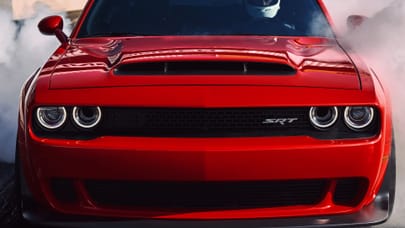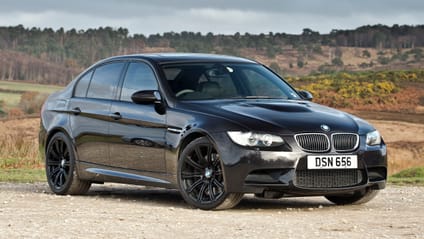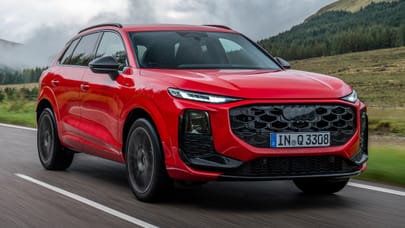
Top Gear's Bargain Heroes: the E90 BMW M3
A V8-powered M3 for less than a 1 Series: your £17k BMW M3 buying guide is here


Words like ‘hero’ and ‘icon’ are thrown about at will where fast cars are concerned. But no one can argue about the BMW M3’s claim to either.
It brought high-performance rear-wheel-drive cars to the mainstream. It's an ideal stepping stone between a hot hatch and a bona fide sports car, wrapping qualities of each in a body that can slip seamlessly into traffic without warranting undue attention.
It’s also matured in a fascinating manner over its 31-year life, growing from a pugnacious little four-cylinder coupe into a turbocharged fire-breathing saloon. It's spawned many iterations along the way, folding hard-top convertibles and two-seat trackday specialists among them.
The car you see here, though, is the only one to use eight cylinders. Sold between 2007 and 2013, the E90-series of M3 used a highly strung V8 engine and came with three different body styles and your choice of two gearboxes.
And you can now buy one for less than £20,000, cheaper than the meekest BMW 1 Series costs new. Read on to find out if you should…
Pictures: Adam Shorrock
Advertisement - Page continues below
The arrival of the M3’s fourth-generation is perhaps the point it really grew up. Its jump from six to eight cylinders also saw its price climb above the £50,000 mark, a real turning point for a car whose remit is being so useable.
Accounting for the £10,000 hike, though, was quite an engine. Okay, so the previous, E46-generation M3 also had a superb drivetrain. But there’s something so special, so senior about the 414bhp 4.0-litre V8 in its replacement. It's irresistible even now.
Operating through either a six-speed manual gearbox or an optional, seven-speed DCT twin-clutch paddleshift transmission, it offered 0-60mph in less than five seconds, 0-100mph in ten seconds, and the 155mph limited top speed inseparable from German sports saloons.

While previous generations of BMW M3 – E30, E36 and E46 – have simple model codes which are relatively well known among petrolheads, this M3 confused things a bit. It launched as an E92 (the two-door coupe), with the E93 (folding hard-top cabrio) and E90 (four-door saloon) following soon after. In this guide, we'll summarise them all as E90.
Coupes proved the most popular, accounting for two-thirds of the 8,262 M3s which came to the UK. At 1,655kg, they are the lightest of this generation of M3, too. The convertible is not the car at its best, especially given its 150kg weight premium, while the saloon is arguably the most desirable of the lot. (If you ignore the mesmerising, 444bhp M3 GTS, of course, a 911 GT3 RS rival of which seven came to the UK…)
The four-door loses the carbon roof that brings a ton of geeky cool to the two-door, but there's something deeply satisfying about such a sensible shape clothing an 8,000rpm-plus screamer and a wild rear-drive chassis. Just 625 came here too, making it the offbeat choice.
Advertisement - Page continues belowAnd if you’re worried it’s just too sensible, then don't fear, as those in the know will still identify it a mile off. Visual flourishes were shared across the range. The ‘power dome’ on the bonnet is the easiest to spot, followed by M-badged side vents, bulging wheel arches and quad pipes at the rear. The front bumper also gets a more intricate design than a standard 3 Series.
Inside, there are clues at all your major touch points. An M-branded gear knob (manual) or stubbly little selector (DCT) is joined by bespoke dials (complete with light-up red line) and a steering wheel with a button marked ‘M’.
This is the button the M3’s driver programmes their favourite, Sunday-morning-blast settings to. How loose they want the stability control, how firm the (optional) adjustable suspension should be, how sharply the gearshift paddles need to react, and so on. The idea? You peel off from the dull A-road, onto your favourite B-road, and simple press one button to transform the car from accomplished premium saloon into madcap M Car.
How it feels to drive today

Without that button pressed, and with its gearbox left to its own devices, the M3 potters around like any other BMW 3 Series. It rides nicely, is easy to see out of, and its large engine delivers low-down power in a refined and effortless manner.
Right, that bit’s out the way. Pottering is not what you buy one of these for. Pull onto an interesting stretch of road, and even without pressing any buttons to prod its mechanicals into ‘attack’ mode, it’s a sharp and wonderfully precise thing.
The hydraulic steering is more natural in its responses than the electronic setup in the current, turbocharged M3, and it allows you to place a front axle that’s rich in grip just where you want it.

But it’s the engine that’s the absolute star of the show. It’s a fine example of just how exciting and intoxicating naturally aspirated engines are, particularly in light of its successor – and nigh on all other performance cars at this level – now moving to turbocharging.
Finding the top of each gear and using all of its performance is harder work, of course, but the rewards are so much greater for it. And then there’s the noise. What starts as a low, muscular burble builds to a screaming crescendo as you pass 8,000rpm and grab another gear, several hundred revs after your instinct nags you to.

The manic, high-rev delivery of its engine is almost supercar-like. Proof of how thrilling it is comes via the DCT gearbox. Far from feeling a cop-out, it's perhaps preferable to the manual. Sorry, purists.
Such is the aggression of its upshifts when you’ve got it switched to the fiercest of its five settings, and so sonorous the blare of revs on a downshift, it adds to the excitement of the engine rather than detracting from it. The manual’s good, too, of course, though it was outsold by DCT across the M3’s life.
Advertisement - Page continues below
The current M3 is known for being a little spiky. Or downright bloody scary, depending on who you ask. But without the instant punch of two turbos, its V8 predecessor is nothing like as terrifying, even when the roads are grimy, wet or icy.
Because you build up its manic crescendo, you work with its power delivery, and always know precisely what you’re asking of its rear axle. There ought to be no unexpected spikes of oversteer, but with the ability to send 414bhp and 295lb ft to the rear axle, misbehaviour is there all day if that’s what you’re after.
It becomes a very excitable car at the upper reaches of its rev range, but with such an enthralling and vocal approach towards 8,300rpm, you won’t have landed there by accident.

Eventually, you’ll reach the end of your favourite road. And if you can resist turning back on yourself, you prod the M3 back into its sensible mode and mooch home in what’s essentially a nicely specced 3 Series.
The dashboard has dated a touch, but BMW has been good at keeping the layout of its interiors and their operational quirks consistent. So it’s the work of a moment to get comfortable, switch the radio on, and cruise along in a quiet, refined saloon.
One that just so happens to have a slightly deranged sports car just about restrained beneath its bodywork…
Advertisement - Page continues belowWhat to watch out for

“The E90 M3 is the best all-round M Car BMW has ever made,” says Dan Norris, director of BMW specialist Munich Legends, and owner of the black car in this feature. “Its versatility is incredible, and it’s like a supercar without the running costs. I’ve driven mine hard everywhere for 50,000 miles, it’s been on track and basically just hooned. And yet it never goes wrong."
Yet there are, like any other performance car, some potentially expensive flaws to keep an eye out for. The E90-gen M3’s Achilles’ heel is its two throttle bodies. If you buy a car where they’ve not been replaced, budget to do so, as it’s something that afflicts every example.
And if one fails – typically the first you’ll know is a fault code, as the car goes into limp-home mode – you should replace both in one go, as the second is likely on its way out, too. Demand brand new parts, as refurbished items will only fail again. They’re £650 each and the replacement of both, including VAT, is around £1,800.
Speak to previous owners to see if this work has already been done. You could be saving yourself money by buying a car that’s already suffered and had the proper fix.

The next big issue to bear in mind is bottom end failure of the engine. The highly strung nature of M Division engines means they’ve never fully escaped problems, and the M3’s V8 – essentially a cut-down version of the M5 V10 of the same era – is no different.
Problems largely occur when owners haven’t been careful with their use or maintenance of the engine, revving it hard from cold or failing to service it meticulously. Engines can live well past 100,000 miles without a blink, while unsympathetic ownership can see major work needed at 50,000 miles.
So check the service history with a keen eye, and again, speak to previous owners about how the car’s been used. It could save you an £8,000 bill for an engine rebuild.

Servicing is a slightly complex one, as the M3 comes with a condition-based system which sees the car's dashboard ping when a service is needed.
As a rough guide, though, the V8 needs an oil change service annually, at around £250, with a more detailed service – new filters, spark plugs, etc – every 40,000 to 50,000 miles, for around £700. Sounds steep, but this is an exceptional engine, and it strikes us as an acceptable area for the M3’s costs to climb above those of a stock 3 Series. And depending on how you use your M3, it might only be every five years such needs arise.
Once again, it’s a good excuse to thumb through the service history. If the mileage tells you this service is looming, it’s a bargaining tool, or a sign to look elsewhere. Also, make sure that the car’s running-in fluids were all changed at 1,000 miles. That first service, early in the car’s life, is helpful to engine longevity.

Other problems? The DCT gearbox can leak oil, which is at least £500 to fix. That’s without taking the gearbox out; the job takes three times as long if it’s removed, so worth speaking to a specialist before the work is done if this affects your car.
The exhaust downpipes can leak and manifolds crack, too, though Munich Legends tells us this is most likely in cars that have been modified or had aftermarket exhaust work done. The warning signs are uneven revs at idle, misfires, or the engine simply shunting itself into limp-home mode.

Munich Legends describes this as “the most cost-effective M car to run”, though everything is relative. Drive it hard and you’ll get around 18mpg; pootle around and it might scrape 30mpg. A reasonable expectation for usage between the two is 22-24mpg. Given some hot hatches sink to that level, we’d argue that’s alright for a V8 saloon.
How much you spend on oil and tyres is all dependent on your tendency to visit tracks or act the imp. Being sensible, you should use around a litre of oil every 4,000 to 5,000 miles, though make sure it’s the proper stuff. Namely Castrol branded, 10W-60 fully synthetic, and it clear on the label that it’s approved for use in BMW M Division cars, which run particularly high oil pressures.
Spend proper money on premium tyres - £250 a corner – and they could last 15,000-20,000 miles if you’re careful. Lots of owners go for cheaper rubber, but expect poorer life, not to mention less predictable grip. Brakes are known to be strong, even if their actual ability isn't fantastic. If you plan to go on track, they’re the first component to upgrade.
How much to pay

The entry point to ownership is with an early E92 M3 coupe; 2007 examples start at a whisker under £17,000. When you can’t even buy a new Mini Cooper S for that, it’s a hugely tempting proposition. Mileage will be 80,000-plus and, given DCT wasn’t introduced at the car’s launch, you’ll be looking at a manual, too.
Up your budget to £20,000 and the full choice of body styles and gearboxes presents itself; DCT cars and convertibles will likely still have a big mileage, but manual coupes will be dropping below the 60,000-mile mark. Another £2,000 opens up a wealth of immaculate, low-mileage cars, and there are plenty of those about, so exercise patience, and shop around.
At £25,000, you’ll have a rich vein of M3s to choose from, including the Competition Pack upgrade (10mm lower suspension, nice 19in alloys and retuned ESP), post-facelift cars (changes were just cosmetic) and with nearly all of them having covered 50,000 miles or below.
Cars which approach £30,000 tend to have very low mileages, or come with individual colour schemes and high specs which previous owners have no doubt spent big money on. Make sure you’re not paying for someone else’s taste deficiency, and prioritise buying a car that’s been mechanically mollycoddled over one that’s an obscure colour.
Oh, and if you want an M3 GT3 or M3 CRT (essentially a four-door version of the GTS), then you’ll need as much patience as you do money. Both exchange hands for £120,000 or more, and fantastic though they both are, they are not six times as good as a tidy, cared for 2007 M3 manual. Our dream garage still has a vacant space for either, though…
"Why I love mine"

Richard Hodge's E90 is his third M3, following an E36 and E46.
“It is an August 2010 car which I purchased in 2013. I went for the four-door variant as I prefer the way it looks, as it is more discreet and you see very few of them around.
“The car is an absolute joy to drive. I love the normally aspirated V8 engine which delivers great performance (with a great noise!). The handling is also sublime and in my view slightly better than the E92 coupe’s.
“I was persuaded to go for the DCT gearbox, which I think is excellent as it allows for easy driving in traffic but when used properly in manual mode allows you to get the most out of the car’s power. It’s not a cheap car to run, but I wouldn’t expect it to be. I struggle to get 20mpg. But servicing costs are reasonable.
“To sum up my view of my E90 M3, I normally look to change my cars every three years. But I’ve owned this one for over three years now, and have no desire at all to change it. I can see myself keeping it for a long time.
“Part of the reason for this will be down to the direction BMW’s M division has gone with turbocharged engines. In my view the latest M3 incarnation is not as good as the one I own.”
Trending this week
- Car Review
Alpine A390







